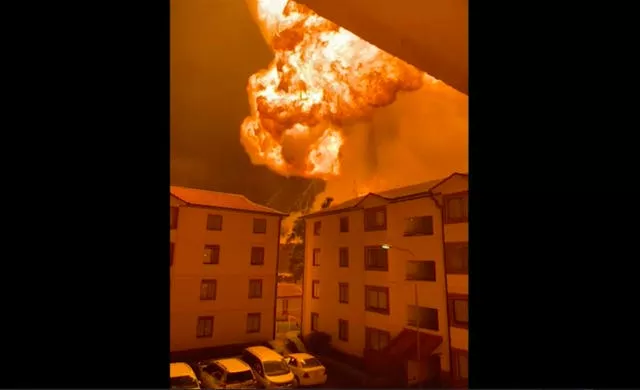A truck loaded with liquid petroleum gas cylinders exploded and set off a late-night inferno that burned homes and warehouses in Kenya’s capital, Nairobi, killing at least three people and injuring more than 270, officials said on Friday.
The death toll was expected to rise and there were at least 24 people were critically injured, the Kenya Red Cross said.
The truck was parked inside a gas cylinder storage and filling site that had multiple applications to operate there rejected last year because it was too close to residential areas, Kenya’s energy and petroleum regulatory authority said, raising questions over whether the site was operating illegally.
Witnesses said they heard a sound they suspected to be gas leaking from inside the storage site before at least two explosions and the massive fire, which broke out at about 11.30pm on Thursday.

A huge fireball lit up the night sky.
Many residents were likely inside their homes when the fire reached their houses in the Mradi area of the Nairobi neighbourhood of Embakasi, government spokesman Isaac Mwaura said.
A flying gas cylinder set off a fire that burned down a nearby garment and textile warehouse, Mwaura said.
Several other vehicles and businesses were damaged by the blaze.

Mobile phone videos taken by witnesses showed the fireball erupting after an explosion right next to some apartment buildings. People were heard screaming.
At the scene after daybreak, several houses and shops were burned out.
The roof of a four-storey residential building about 200 metres from the scene of the explosion was broken by another flying gas cylinder. Electric wires lay on the ground.
Nothing remained in the burned-out gas storage site except the shells of several trucks.

Local resident Alfred Juma said residents told him they suspected there was a gas leak and he heard a loud noise from a cylinder in the storage site next to his house when he came outside.
“I started waking up neighbours asking them to leave,” Mr Juma said.
He said he warned a black car not to drive through the area, but the driver insisted and his vehicle stalled because of the gas fumes.
“He attempted to start the car three times and that’s when there was an explosion and the fire spread … setting off other explosions.”
The shell of that black vehicle was lying on its side in the aftermath.
Mr Juma said he grabbed two children and they hid in a sewage ditch until the explosions ended. His family hadn’t been at home, but Juma lost everything he owned in the fire.
Another witness, Charles Mainge, said locals had previous concerns over the gas site operating in the area.
He said there were at least two main explosions, the second of which knocked him and others off their feet after they left their houses to see what was happening.
“The government knew this liquid petroleum gas plant was existing in a residential area but they did nothing,” he said. “They should make sure this doesn’t happen again.”
Police and the Kenya Red Cross reported three deaths and that toll may rise, said Wesley Kimeto, the Embakasi police chief.
The government and Red Cross said 271 people were taken to several hospitals with injuries.
Police had moved people out of the area and were preventing them from returning to their homes, resident Caroline Karanja said.
She said the smell and the smoke were still choking and she would have to stay away for a while because she had young children.
The energy and petroleum regulatory authority said the gas storage site had made applications for construction permits to build a plant and operate there in March, June and July last year.
“All applications were rejected as they did not meet the set criteria for an LPG (liquid petroleum gas) storage and filling plant in that area,” the authority said in a statement on Friday.
“The main reason for the rejection was failure of the designs to meet the safety distances stipulated.”
One of the stipulations was that the gas business submit a risk assessment called a “blast profile”, which would estimate how surrounding areas would be impacted in the event of an explosion, the regulatory authority said. The gas storage business never submitted those assessments, it said.
The continued operation of the gas storage and filling site is likely to put authorities’ enforcement of regulations under heavy scrutiny. Officials at the county government have been accused of taking bribes to overlook building codes and other regulations.







